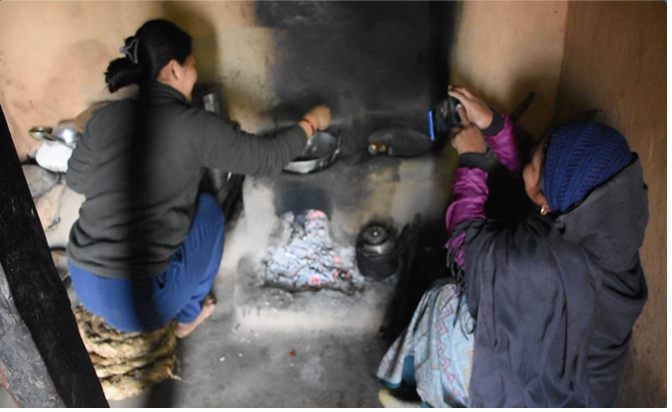Hornet Farming: Exploring the Indigenous Food Practices of a Magar Community in Nepal
by Kamal Raj Devkota, PhD, Assistant Professor, Department of Education, Tribhuvan University
Co-Investigator on ‘Empowering communities through university partnership in public health: a pilot project in Nepal and the Philippines’, funded by Medical Research Council, UK.
The Asian hornet (Vespa velutina), a yellow-legged hornet, is found in different parts of South Asian countries. In Nepal, different communities including Magars consider hornet larvae as a delicious food with a cultural and religious value. Magar is an ethnic community inhabiting mostly the central hill districts in Nepal and they have rich linguistic and cultural traditions. During our fieldwork for the research project on the ‘Empowering Communities’ project (based in CORTH and funded by the Medical Research Council), we investigated indigenous food practices among some Magar families in Sahid Lakhan Rural Municipality of Gorkha district (a central hill district of Nepal).
On first morning of our fieldwork, we happened to meet six people at a home in the Gairiswara Magar community who were chatting and drinking local liquor. We became fascinated with their discussion of hornet farming in their village. Kulman Magar, a seventy-year-old man, said that hunting yellow-legged hornet nests (hives) in the nearby forests was common in his village. He reminisced about his childhood: “We would often go to the jungles to hunt hornet hives. Once we found the hive, we would burn it in the late evening and collect larvae. We never burnt it at noon as the hornets could sting us to death, it is dangerous.” He added, “Hunting hornets was culturally important for us; we need some roasted hornet larvae to offer our deities during our religious and ritual tasks; it is delicious and the best food to eat with liquor.” There were other neighbours drinking and chatting when we met Kulman at home. Bir Man, Kulman’s brother and a retired Indian army member living next door, smiled curiously and said, “You know Sir, our ancestors do not get happy if we forget to offer hornet and local liquor, it is always necessary to accomplish our dharma (religious tasks).”






Images from left to right: 1 Asian Hornet. 2 Grown-up hornet nest transferred from the jungle. 3 Hornet larvae taken out from nest and dried on a bamboo plate. 4 Hornet larvae and other ingredients for cooking, 5 Rima cooking hornet larvae while her neighbour is clicking photos, 5. Hornet dish ready to eat
Many people from that village and other Magar villages nearby started hornet farming for the last few years. For the first time in Gairiswara village, Man Bahadur Thapa Magar, the eldest son of Kulman Magar started farming hornets at home. During our interview, Man Bahadur explained, “We would keep bees at home; I was surprised when I heard about farming hornets first; I felt how it would be impossible as hornets are always dangerous. But later, I started doing it. I went to the forest nearby and looked for the start-up nests (start-on hives) with a few parent hornets. In the evening, I collected them and transferred them to my farm. Gradually, I learned the techniques, I cultivated them until the nest grew big hives, and we sold larvae in the market at last.” He added, “Comparatively, it requires less effort; once we transfer the small start-up nests into our farm, we need not do more, only we need to know when the hornets produce more larvae and when to collect them; I found it easier to earn money.” Man Bahadur’s venture motivated other Magar farmers – not only from his village but also those of nearby villages. Many villagers of Gairiswara referred a farmer from Ranagaun Magar village who earned about 300000 rupees ($2307) by selling the larvae to the luxury hotels hotels in big cities, including Kathmandu.
The Magar men and women of the Gairiswara explained that they include hornet larvae as a nutritious food. Rima, a Magar woman in her early twenties and working as the Female Community Health Volunteer for her community, explained that it is a good source of protein. One morning, we found her cooking hornet larvae in the kitchen. She said that she had already dried the larvae once it was boiled. She fried it in cooking oil. She added onion, tomato, green chilies, garlic, ginger, coriander and other spices. She said that in her community, the local alcohol and malt pair well with cooked hornet larvae, so the men of her community always prefer to eat while drinking. Women – especially pregnant women and the mother after giving birth to a baby – prefer it as a good source of nutrients.
In a conversation with us, Rima and her neighbors repeatedly explained that they learnt all about hornets, hunting hornets from the jungle, and cooking and serving it as a delicious food with the local liquor, from their parents and grandparents. However, they said that hornet farming transferring a small nest from the jungle to the nearby farm at home is really strange and exciting. They added that it could be a very good alternative opportunity for earning and leading livelihood with little effort.
